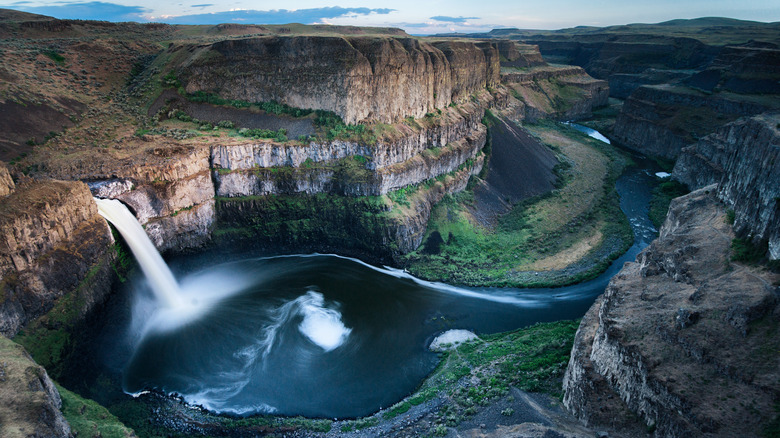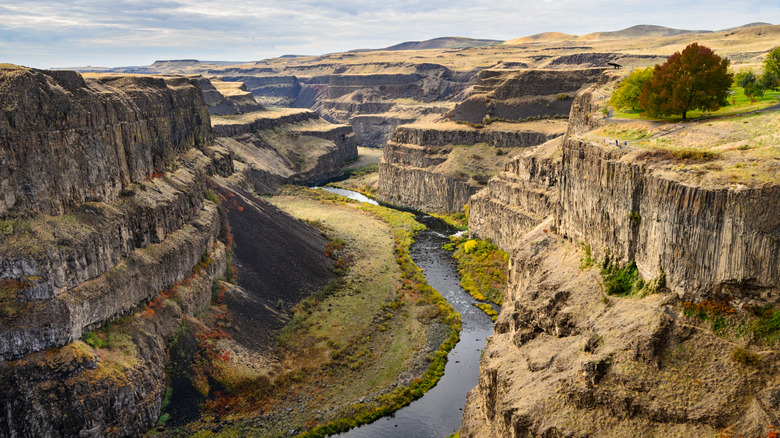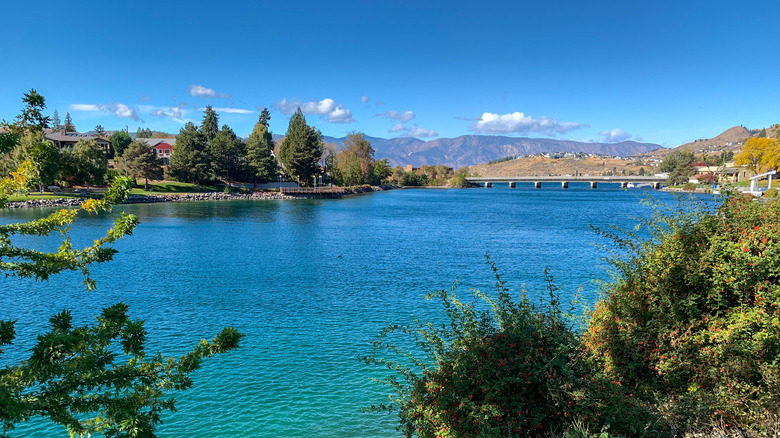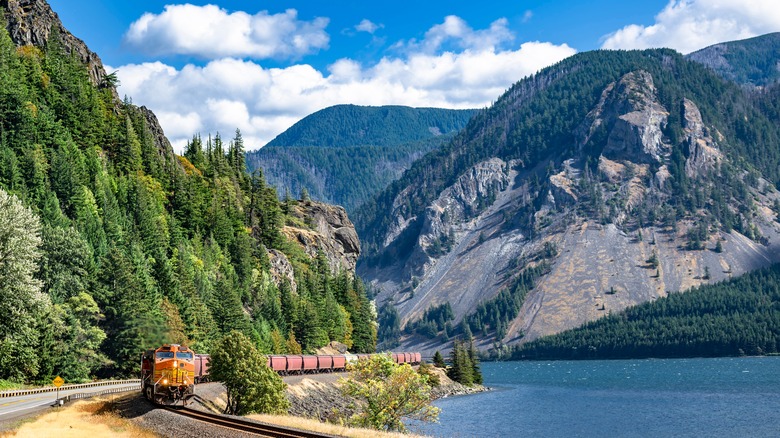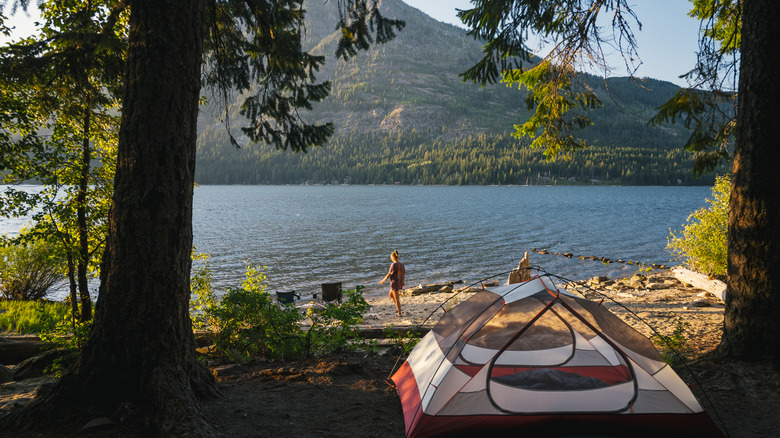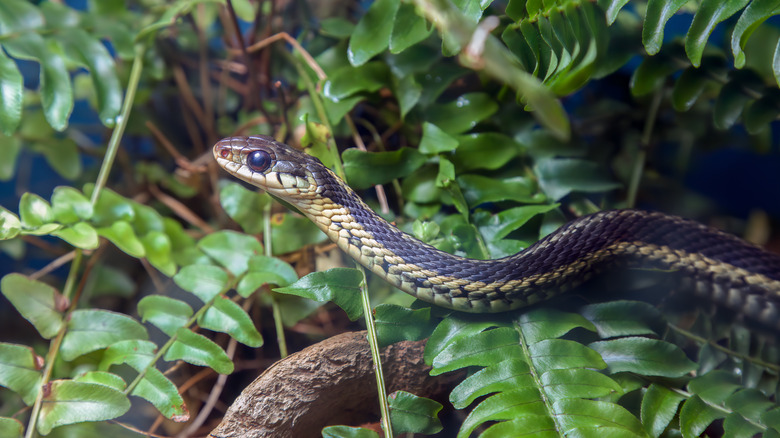Washington's Most Snake-Filled Lakes And Rivers Might Make You Think Twice Before Diving In
We get it — snakes are far from everyone's favorite animal. While they are fascinating creatures in their own right and serve a crucial role in the ecosystems they inhabit, chances are that when you're out hiking through the woods or wading in a lake, you'd rather not see one. For all its natural draws, you might be surprised to learn that the great state of Washington is home to a very healthy population of various snake species, including the Western rattlesnake, rubber boa, Western yellow-bellied racer, and several more.
So, whether you're headed to eastern Washington's underrated region of lush rolling hills and charming small towns or exploring the state's hidden island full of parks, beaches, and seafood, you'll want to equip yourself with the knowledge of what animals call these places home as much as with proper hiking gear. With summer in full swing, locals and visitors alike will be flocking to the state's shimmering swim spots. Some of those lakes and rivers, however, are more likely to host snakes than others, so we're here to break down four places in Washington where you should be extra careful before taking a dip.
Before we dive into it (pun very much intended), it's important to note that snakes are not the menacing monsters they're often portrayed as in the media. In reality, they're not slimy, nor do they seek out people to bite. And as is true for just about every other living thing in the animal kingdom, they're simply trying to go about their lives and are more afraid of you than you are of them. If you happen to come across one in the wild while you're out hiking or swimming, give it space, leave it alone, and you'll likely never see it again.
Snake River
No surprise here. Snake River runs through the Southeastern portion of Washington, a region that receives 300 days of sunshine a year and is distinctly different from the lush, rain-laden region to the west. Dry and hot summers mean it's the perfect place for reptiles looking to warm themselves in the sun. The Snake River's steep embankments and rocky ledges form the ideal habitat for species like the Western rattlesnake, yellow-bellied racers, and the common garter snake. Be aware of piles of driftwood and open slabs of rock on the riverbank. Anglers should be particularly careful of coves and brush piles along the water's edge.
If you happen upon a common garter snake, there's little to worry about. These semi-aquatic creatures go after small fish and amphibians for food and only have enough venom in them to cause you the equivalent of a bee sting pain-wise. Their black bodies are edged by vivid yellow stripes and small red dots where yellow meets black. Adult yellow-bellied racers are usually around 30 to 70 inches in length, have relatively narrow bodies compared to other snake species, tails that resemble a whip, and feature a solid color on their backs and a hazy yellow on their bellies and sides. Despite the name, these slowpokes can only move at a mere 4 miles per hour. Racers are also non-venomous and want nothing to do with you.
The Western rattlesnake, however, is one to watch for. This large venomous snake only bites when threatened, though its neurotoxins are rarely fatal to humans (a bite will cause swelling and discoloration, though). Telltale giveaways are the rattle on the tail and their triangular-shaped heads. When near the river, stay alert, watch your step when moving over rocks, and wear water shoes for good measure.
Lake Chelan
Lake Chelan is a beautiful cerulean strip of water in central Washington that spans 50 square miles and reaches depths of up to 1,500 feet, making it America's third-deepest lake. The Lake Chelan Valley as a whole attracts more than 2 million visitors annually, according to the Lake Chelan Chamber of Commerce, and the lake here is a popular summer destination for locals and visitors. It also happens to be home to several members of Washington's snake family, including the gopher snake, all three varieties of garter snakes (common, Northwestern, and terrestrial), and the occasional Northern Pacific or Western rattler.
The lake's surrounding geography is made of dry slopes that descend into the water and craggy ravines. The Chelan Butte area, located on the lake's southern end, has a reputation for snake encounters, but keep an eye out for them on sun-soaked trails and open areas of shoreline, whatever part of the lake you're on. Bushes, the shaded areas of boulders, and dry hills are ideal hunting and resting territory for snakes, and a calm alertness will always serve you well while passing through these areas.
A word about the gopher snake: It's the largest in the state, growing anywhere from 3 to 7 feet in length, and due to their brownish, yellow-grey coloration and size, they're often mistaken for rattlers. The good news is they are non-venomous, if a bit intimidating. They'll hiss and shake their tails if they feel threatened, and that tail shake can easily make them sound like a rattler if it brushes up against any dried vegetation. The best way to tell if you're dealing with a rattler or a gopher is by looking at the head: Gopher snakes have much slimmer heads compared to rattlers' broad ones.
The Columbia River and Columbia River Gorge
The Columbia River is Washington's mightiest waterway, stretching over 1,200 miles across the state and carving a deep gorge between the state and Oregon. As it makes its way down from the north, the Columbia passes through the dry region near the Tri-Cities area in the state's south (which includes towns like Richland, Kennewick, and Pasco). The dramatic basalt cliffs and open shrubland lining the river in this region are home to a variety of snake species, including the night snake, gopher snake, and California mountain kingsnake.
Encounters are especially common at Chamna Natural Preserve and Bateman Island in Richland, particularly on exposed rock surfaces. The Chamna Natural Preserve is a well-frequented hiking and biking destination for Richland residents, so if you're planning a visit there, don't hesitate to talk to the locals to get the most up-to-date info on snake sightings.
Further downstream is the striking Columbia River Gorge, where you're more likely to find the rubber boa, ringneck snake, garters, rattlesnakes, and striped whipsnakes. California mountain kingsnakes are a notable case, as their white and red stripes and black bands cause them to be confused for the highly venomous coral snake. Thankfully, this snake is not venomous, and even better, there are no coral snakes in Washington at all, as their range extends from the southern U.S. down to Argentina. Regardless, remember that snake activity along the Columbia River will always be higher in its drier, warmer sections. But even if you find yourself by the water along the river's chillier, more forested portions, it's best to stay alert and practice basic snake awareness.
Lake Wenatchee
Lake Wenatchee may seem like an unusual choice for snakes to make their home, given its location in the lush, cool environment of the Okanogan-Wenatchee National Forest in Western Washington. But at least eight species — from rubber boa and night snakes to racers, garters, and gopher snakes — can be found here. Rattlesnakes and other reptilian creatures that prefer warmer and drier climates are generally not spotted here, though their presence isn't an impossibility.
The nearby national forest provides 3.8 million acres of an ecological boost to the region, which is one of the reasons why snakes are so common at the lake (and why you can't rule out rattlesnakes from the area). Wenatchee's wooded, stony shores provide ample logs and rocks for snakes to hide and hunt beneath, and nearby riparian meadows are ideal basking spots for snakes looking for warmth around the brisk, glacier-fed body of water. All the standard snake awareness guidelines apply here: Wear closed-toe shoes when possible, watch where you're walking, avoid logjams on trails and thick undergrowth, and pay attention if you're sunning yourself on the rocks, because you might not be the only one getting a tan.
Once you're done checking out the lake, head to the city of Wenatchee, an hour's drive to the south. Wenatchee is the apple capital of the world and is laden with orchards, wineries, and wildflowers, and it's well worth a visit any time of the year.
Snake safety and wisdom: Coexisting, not cowering
Despite their prevalence, snakes pose little risk to humans. With your awareness and respect, Washington's diverse snake community can become a fascinating feature of your summer outdoor outing, not a cause for alarm. Snakes are a natural part of the ecosystem, helping to regulate rodent populations and playing their own role in the food chain for other predators.
If you do encounter a snake, experts recommend giving it at least three feet of space and backing away slowly rather than approaching or startling it in any way. Never attempt to catch, handle, or kill a snake (in fact, it's illegal to capture or kill native snakes under Washington law). In the unlikely event of a snakebite, particularly from a rattlesnake, time and composure matter. Begin by calling 911 and the Washington Poison Center. This 24/7 hotline connects you to medical professionals who guide you through first aid and the proper steps to ensure your well-being.
If you think you've been bitten by a venomous snake, keep the limb immobilized and below heart level. Bites from venomous snakes usually result in significant pain and swelling at and around the wound. Nausea, difficulty breathing, and fatigue are all normal symptoms. And, while it's difficult, do your best to stay calm and minimize movement. A lower heart rate will help slow the spread of venom throughout your body. Remember, snakebites are rarely fatal when treated properly. Of the approximately 8,000 people bitten by snakes each year, roughly five die. So, stay calm, call for help, and get to a medical facility as soon as possible. By understanding snake behavior and following simple precautions, you can safely share Washington's waters and trails with its scaly residents, and maybe even gain a new appreciation for them.
